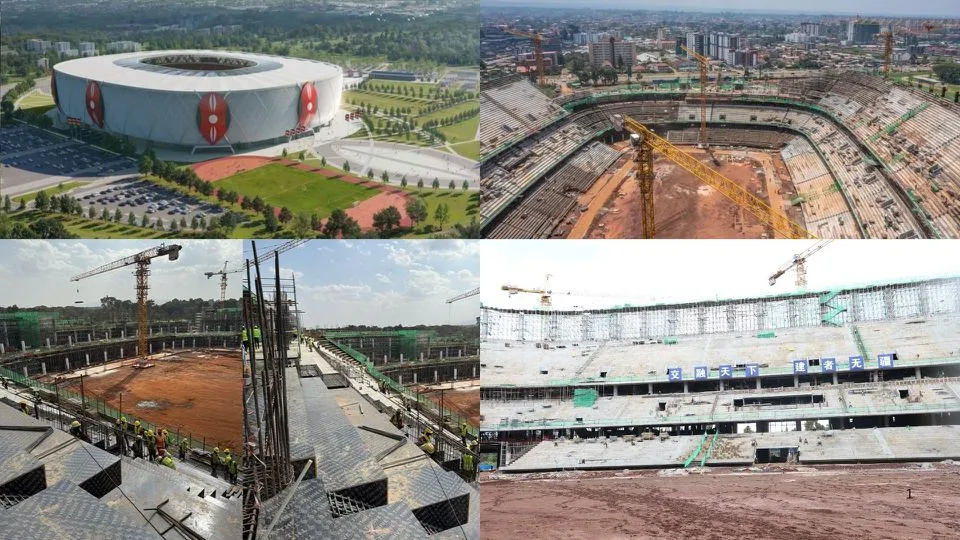The Talanta Sports Stadium stands not just as a construction marvel but as a symbol of Kenya’s ambitions in the world of sport. As Nairobi’s skyline evolves with the silhouette of this 60,000-seater stadium, a new era beckons for Kenyan football, marking the country’s readiness to step confidently onto Africa’s biggest sporting stage. With the countdown to the 2027 Africa Cup of Nations (AFCON 2027) underway, the story of Talanta Sports Stadium is a rich tapestry woven with innovation, national pride, and not least, controversy over its massive price tag.
Changing the game in Kenyan sports infrastructure
The Talanta Sports Stadium, set on Ngong Road in Nairobi’s Jamhuri precinct, is billed as a game changer in a country that has long grappled with ageing and inadequate sporting infrastructure. For decades, Kenyan sports fans and athletes have watched major tournaments bypass Nairobi, but now, with construction well underway and the government’s explicit promise to have the stadium ready by December 2025, there is genuine optimism. The stadium has been earmarked to serve as the main stage for the AFCON 2027, a prospect that has excited supporters and athletes alike.
While the country is abuzz with anticipation, the escalating cost of the project—an eye-watering KSh 44.7 billion ($344.5 million)—has sparked heated public debate. Critics have wondered aloud whether the price tag is justified, especially when compared to neighbouring nations and global sporting hubs.
Unpacking the numbers behind Talanta Sports Stadium
Funding for Talanta Sports Stadium did not follow the usual script. The project is being financed through infrastructure bonds issued by Linzi Finco, and the response from Kenyan investors was overwhelming, with the bond fully subscribed and raising KSh 44.875 billion. These bonds promise an impressive 15.04 percent annual return over 15 years, outpacing comparable infrastructure bonds in Kenya, which tend to return around 13 percent. Principal and interest are to be paid semi-annually, with the principal spread in equal annual installments.
While this funding approach is innovative, it also means that Kenya could pay up to KSh 100 billion over the bond’s lifetime, factoring in interest. This has contributed to the heated national conversation, with many Kenyans expressing concern that these funds might have financed multiple stadiums. Yet, there is a palpable sense of ownership and pride among local investors, knowing the project is rooted firmly in Kenyan hands.
How does Talanta’s cost stack up regionally and globally?
To understand the magnitude of this investment, consider these comparisons:
- this is how it’s done – Benjamin Mkapa Stadium in Tanzania, also a 60,000-seater, was built in 2007 for KSh 7.22 billion, a sum dwarfed by Talanta’s price tag,
- this is how it’s done squared – Uganda’s Mandela National Stadium cost KSh 4.64 billion in 1997, again with a dramatic difference in scale,
- this is how it’s done cubed – South Africa’s FNB Stadium, expanded in preparation for the 2010 FIFA World Cup, reached KSh 56.8 billion after renovations, making it Africa’s costliest, yet boasting nearly twice Talanta’s capacity.
Even when stacked against international giants, discrepancies are evident but context matters. For example, Arsenal’s Emirates Stadium, which opened in 2006 at a cost of KSh 72.5 billion, or the immense SoFi Stadium in California, topping the global list at KSh 825 billion, serve not only as sports venues but multi-year investments in prestige and entertainment economies.
| CASINO | BONUS | INFO | RATING | |
|---|---|---|---|---|
|
bonus
First Bonus: 200% Deposit Bonus
See 3 Bonuses
|
info
8048/JAZ2024-001 HunnyPlay is licensed under Curaçao (365/JAZ). Join now and win crypto instantly! |
|||
|
bonus
New players get 50 free spins and a Ksh 2500 freebet!
See 7 Bonuses
|
info
BK 0000665 PG 0000405 Good combination of online casino and betting platform |
|||
|
bonus
Bonus on 1st deposit: Free Bet up to 10,000 KES
See 3 Bonuses
|
info
BCLB 0000794 Licensed betting platform with a variety of bonuses and high odds |
|||
|
bonus
Daily 25% bonus on your deposits!
See 6 Bonuses
|
info
Curacao 1668/JAZ Generous casino bonuses |
Architectural flair and a nod to heritage
Beneath the heated debates about cost and construction pace, the design of Talanta Sports Stadium emerges as a story worth telling. Inspired by Kenya’s distinctive cultural icons like Maasai shields and spears, the architecture fuses local heritage with international sporting standards. It is both a monument to Kenyan identity and a beacon of modernity.
Its football-focused design sets it apart: unlike other Kenyan arenas, this stadium will not include a tartan athletics track. Its playing field is strictly football, with rugby matches to be held occasionally, while adjacent fields for athletics accommodate multi-sport needs outside the main facility. This decision aligns with international norms for elite football competitions and reflects a commitment to creating an optimal environment for the sport.
Beyond the pitch: Facilities and national vision
Talanta Sports Stadium’s facilities read like a checklist for top international events: seven modern changing rooms, VIP lounges, advanced media centers, dedicated VAR booths, and goal-line technology. These features ensure compliance with Confederation of African Football (CAF) standards and the expectations of players, officials, and fans from across the continent.
The stadium is also conceived as a multipurpose venue. Besides its sporting credentials, it will host concerts, cultural events, and exhibitions, reinforcing its role as a hub for social cohesion and national pride. In a country where sports are woven deeply into the societal fabric, Talanta Stadium is poised to become more than a site for matches, evolving into a focal point for Kenyan culture and celebration.
Why Talanta matters beyond 2027
For Kenya, Talanta Sports Stadium represents more than the fulfilment of a sporting dream. It is a public commitment to raise standards, nurture young talent, and showcase Kenyan hospitality to the continent and beyond during AFCON 2027. With the project led by China Road and Bridge Construction Company and inaugurated by President William Ruto, the sense of urgency and national focus is apparent.
As construction enters its final year, the site stands as a testament to collective ambition, investment, and the dream of hosting Africa’s finest on home soil. The hope is that, beyond the headlines and disagreements about financing, the stadium will anchor a new chapter in Kenyan sports—one defined by unity, pride, and the memorable roar of 60,000 fans under Nairobi skies.
A legacy in the making
As Talanta Sports Stadium rises, so too does the spirit of Kenyan sport. The heated debates, innovative financing, and inspired design have created more than just a venue—they have sparked a national conversation about vision, value, and what it truly means to invest in a nation’s future. By December 2025, when fans finally step into the finished stadium, the hope is not just for glory on the pitch, but for a shared sense of achievement that resonates far beyond the city limits of Nairobi.










